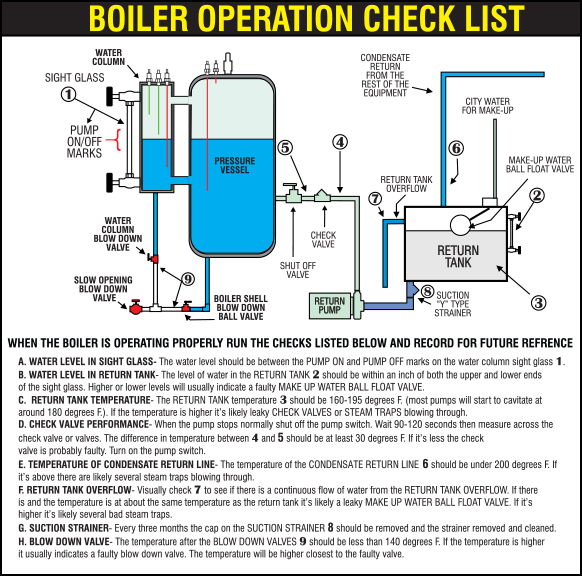Troubleshooting is the subject you’ve probably been waiting for since these articles on boilers began. Before troubleshooting any equipment, remember never to rush in with assumptions about the problem. Take a moment to think about how the machine would behave when operating correctly and then compare that with what is happening. Remember always the “KISS” principle (KEEP IT SIMPLE STUPID). Most machinery problems are not exotic and are easily discovered. Unfortunately, repairing machinery faults will probably be more of a problem than finding them. Before beginning brain surgery, it is always a good idea to find out if that headache might be caused by a collar that is too tight.
With that thought in mind, always start with the basics required for proper boiler operation. Basics include the utilities required, such as electric power and gas. You would be amazed at the number of wild goose chases that result from rushing into a troubleshooting session with faulty assumptions without creating a logical progression of tests, sort of a checklist for troubleshooting the problem. Incidentally, the checklist concept is helpful for all machinery troubleshooting.
1 Check the electrical power (don’t just look at the breaker panel. Reset the circuit breakers for the machine in question).
2. Control panel interlock switch that senses the door closure of the boiler electrical panel is on.
3. The emergency shut-off switch outside the boiler room is on.
4. Makeup water line to return tank on.
5. Gas to boiler on.
Having eliminated the “no-brainer problems,” which cause at least 20% of my service calls, let’s move on to actual machine troubleshooting.
Troubleshooting any type of equipment employs 4 basic procedures:
1. OBSERVE- Get yourself a good flashlight and do an in-depth visual inspection of the machine in question (boiler, press, dry cleaning machine, etc.). Look for discolored or misshapen wires or components in control panels, sparks, smoke or burning odor, drips or leaks of oil solvent or water, and accumulations of debris such as metal or rubber dust or grounds. With the plant quiet, listen for air or steam leaks (WHEN WORKING AROUND BOILERS AND AIR COMPRESSORS, ALWAYS USE PROTECTIVE EYEWARE AND NEVER PUT YOUR EARS OR EYES ANYWHERE NEAR A SUSPECTED LEAK). Finding any of the above conditions will help to localize the problem.
2. MEASURE- Quantitative measurement would require instruments of some sort: volt meters, ohm meters, pyrometers, calipers, etc. We will not be using any of these in the following procedures. Instead, we will measure qualitatively, carefully using our sense of touch and vision. (USE ONLY THE TIP OF A FINGER WHEN SENSING TEMPERATURE, AND NEVER GRAB OR GRASP AN OBJECT IF YOU ARE NOT SURE OF THE TEMPERATURE. IF YOU SUSPECT THE TEMPERATURE OF THE SURFACE TO BE HOT, WET THE TIP OF YOUR FINGER WITH SOME SPIT BEFORE TOUCHING) First, think about the range of temperatures the object in question could be. Then, think about the temperature range that the object should be if the machine were operating correctly. Now, touch the object to see how it compares to the proper temperature.
3. EXPERIMENT- When you suspect a faulty part, do something to change how that part works within the machine. Is there a way to bypass or isolate it or turn it off?
Can you make the problem worse or better by doing something? Can you easily replace the part and see how the machine operates?
To help eliminate the no-brainer type of problems, follow the checks in the illustration accompanying this article.
Well, that’s it for this month. Look for a downloadable PDF file of this article on my FIXIT-ACADEMY website www.fixit-academy.net , where even an amateur can learn to make their own equipment repairs.

I’ll be giving a workshop in Las Vegas in March on the following subjects:
- How to use a multi-meter for common in-plant electrical troubleshooting.
- How to replace the guts of steam traps without messing with pipework.
- How to safely replace the sight glass on your boiler.
The instructions will be given in English. For more information, call 702-376-6693 or email bruce@fixit-academy.net

Bruce Grossman
Bruce Grossman is the Chief of R&D for EZtimers Manufacturing. EZtimers is the manufacturer of the new EZ DOSE boiler compound manager and return tank level control which replaces that troublesome ball float valve in the condensate return tank and automatically adds the correct amount of boiler compound to the return tank preventing the oxygen corrosion and scaling. Our SAHARA and DIB-M high purity separator water mister/evaporators provide a thrifty, legal method to get rid of the separator water generated by your dry-cleaning machine. See our Ad in this issue and for further information on EZtimers products visit www.eztimers.com Please address any questions or comments for Bruce to bruce@eztimers.com or call 702-376-6693.

